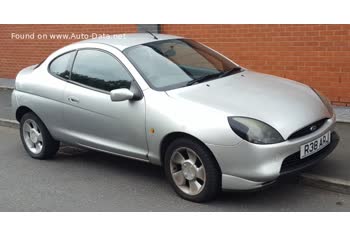Everything you need to know about specifications and performance - Ford Puma Puma 2020 - 1.0 EcoBoost (125 Hp) Automatic

Overview:
What is the engine capacity of a Ford Puma 2020?
The engine capacity of the Ford Puma 2020 is 999.
Ford Puma 2020 How many horsepower?
The engine power of the Ford Puma 2020 is 125 Hp @ 6000 rpm..
What is the Ford Puma 2020 engine?
Ford Puma 2020 engine is B7JE. (Click to see other cars using the same engine)
How much gasoline does a Ford Puma 2020 consume?
The Ford Puma 2020 consumes 4.9-5 liters of gasoline per 100 km
General:
Brand: Ford
Model: Puma
Generation: Puma
Modification (Engine): 1.0 EcoBoost (125 Hp) Automatic
Start of production: June, 2020
End of production: March, 2021
Powertrain Architecture: Internal Combustion Engine
Body type: SUV, Crossover
Seats: 5
Doors: 5
Engine:
Engine systems: Start & Stop System
Power: 125 hp @ 6000 rpm.
Power per litre: 125.1 hp/l
Torque: 200 nm @ 1400 rpm.
Engine Model/Code:B7JE
Engine displacement: 999
Number of cylinders: 3
Engine configuration: Inline
Number of valves per cylinder: 4
Fuel injection system: Direct injection
Engine aspiration: Turbocharger, Intercooler
Valvetrain: DOHC
Engine oil capacity: 4.6 l
Coolant: 5.6 l
Engine layout: Front, Transverse
Performance:
Fuel Type: Petrol (Gasoline)
Fuel consumption (economy) - urban: 5.8-6 l/100 km
Fuel consumption (economy) - extra urban: 4.3-4.4 l/100 km
Fuel consumption (economy) - urban (NEDC, WLTP equivalent): 5.8-6 l/100 km
Fuel consumption (economy) - extra urban (NEDC, WLTP equivalent): 4.3-4.4 l/100 km
Fuel consumption (economy) - combined (NEDC, WLTP equivalent): 4.9-5 l/100 km
Fuel consumption (economy) - combined: 4.9-5 l/100 km
Emission standard: Euro 6d-ISC-Fcm
Acceleration 0 - 100 km/h: 10.2 sec
Acceleration 0 - 62 mph: 10.2 sec
Maximum speed: 187 km/h
Weight-to-power ratio: 10.6 kg/Hp, 94.3 Hp/tonne
Weight-to-torque ratio: 6.6 kg/Nm, 150.8 Nm/tonne
Acceleration 0 - 60 mph: 9.7 sec
Space:
Kerb Weight (kg): 1326
Max. weight (kg): 1815
Max. roof load: 50 kg
Max load (kg): 489
Trunk (boot) space - maximum: 1216 l
Trunk (boot) space - minimum: 456 l
Permitted trailer load with brakes (12%): 900 kg
Permitted trailer load without brakes: 660 kg
Permitted towbar download: 75 kg
Permitted trailer load with brakes (8%): 900 kg
dimensions:
Length: 4186-4207 mm
Width: 1805 mm
Height: 1534-1536 mm
wheelbase: 2588 mm
Width with mirrors folded: 1805 mm
Width including mirrors: 1930 mm
Front overhang: 850-856 mm
Rear overhang: 748-763 mm
Ride height (ground clearance): 164-166 mm
Minimum turning circle (turning diameter): 10.3-10.6 m
Powertrain, Suspension and Brakes:
Drivetrain Architecture: The Internal combustion Engine (ICE) drives the front wheels of the vehicle.
Drive wheel: Front wheel drive
Number of gears and type of gearbox: 7 gears, automatic transmission
Front brakes: Disc
Rear brakes: Disc
Assisting systems: ABS (Anti-lock braking system)
Steering type: Steering rack and pinion
Tires size: 215/55 R17; 215/50 R18
Wheel rims size: 7J x 17; 7J x 18
See also

Last generation.
Its production began in 2024 until Now

Other generation.
Its production began in 1997 until 2003

Same production year and almost the same engine capacity.
Its production began in 2020 until Now

Write a comment